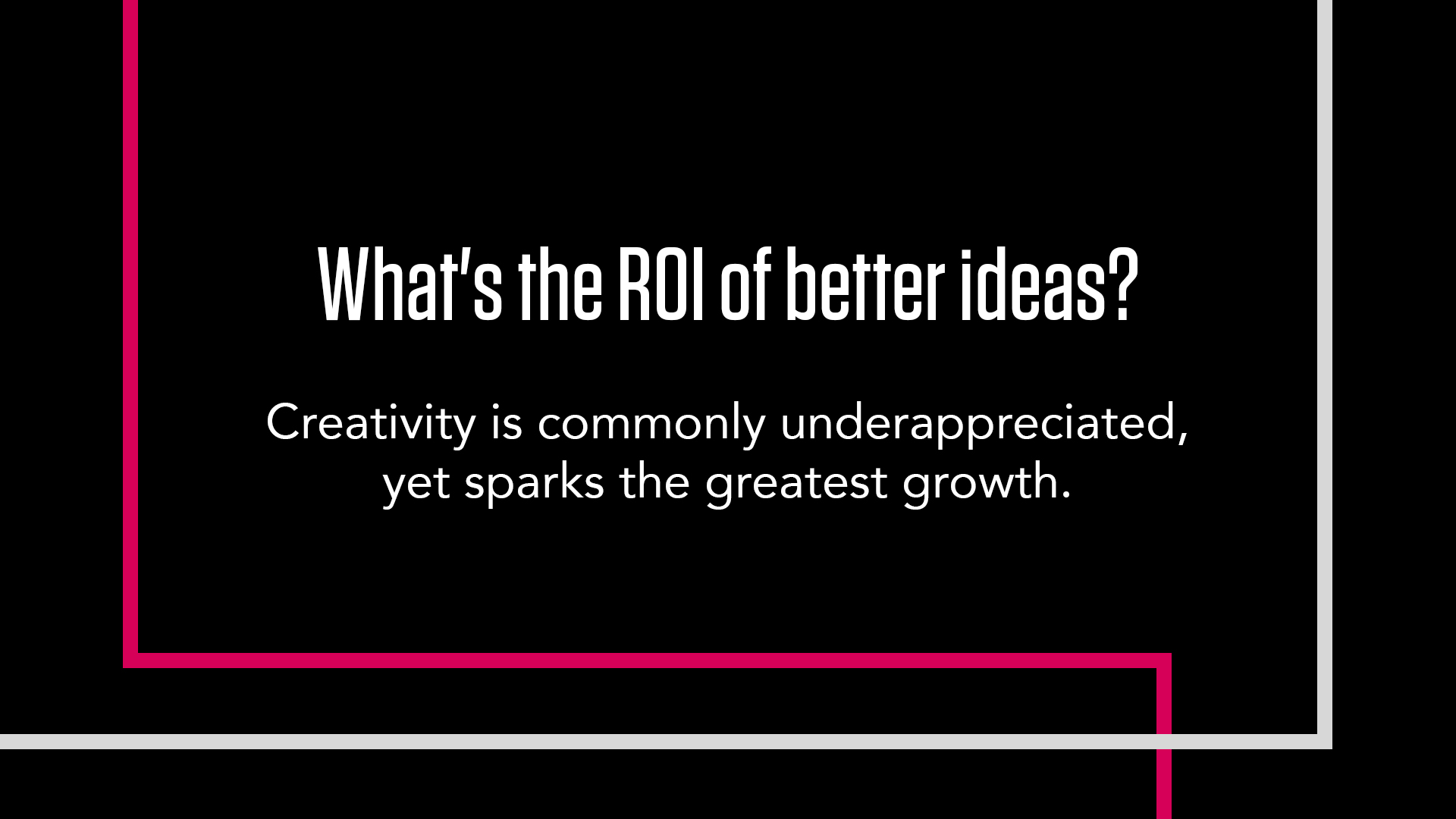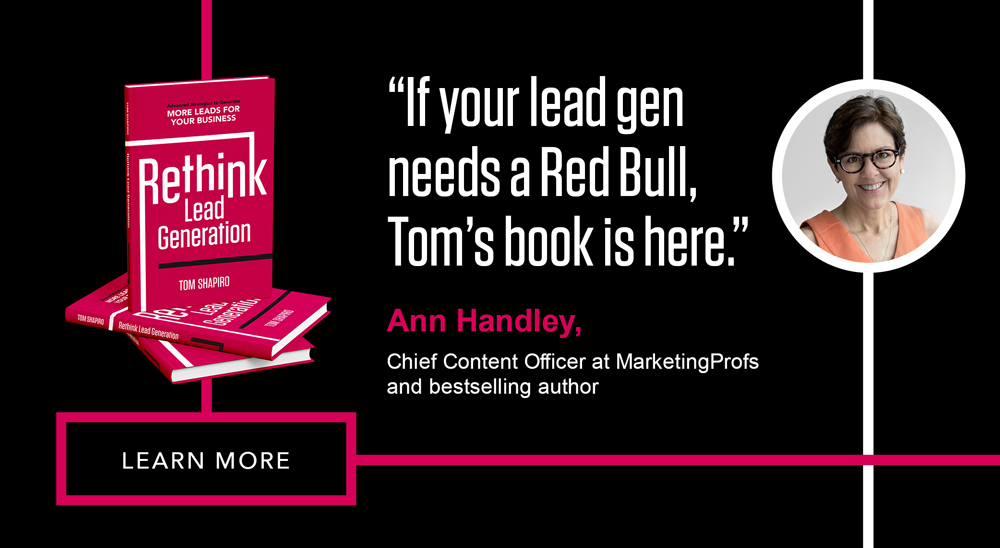Exploring Lead Generation Strategies with Clearscope’s Bernard Huang

Lead generation is the fuel that powers B2B businesses. A new, effective lead generation strategy propels a company towards accelerated growth.
With this in mind, Clearscope Co-founder Bernard Huang joined Stratabeat CEO Tom Shapiro in exploring lead generation strategies in anticipation of Shapiro’s upcoming book, Rethink Lead Generation—Advanced Strategies to Generate More Leads for Your Business.
Clearscope is an AI-based SEO platform that helps you to achieve better organic rankings and content results. The platform enables you to produce content that’s highly relevant to what people are searching for. Clearscope helps you to achieve better content planning and optimization, and empowers you to significantly improve your lead generation results.
Grab your coffee, sit back, and hit play to listen to Huang and Shapiro explore lead generation ideas and strategies.
SUMMARY:
The following are excerpts (slightly edited to help you save time), talking points, and takeaways from the discussion.
Tom Shapiro (Stratabeat): Hello and welcome everyone. I’m Tom Shapiro. I’m the CEO of Stratabeat, which is a B2B organic growth agency. Today, I am joined by Bernard Huang, who is the co-founder of Clearscope, which is an AI-based platform to help you generate greater SEO and content results. Welcome, Bernard.
Bernard Huang (Clearscope): Thanks for having me, Tom.
Shapiro: Oh, it’s fantastic having you. Well, today, I’ll let you know that we’re going to do things a little differently. We’re going to talk about lead generation. I have written my second book, Rethink Lead Generation, and it’s all about how B2B marketers can generate greater leads through extreme creativity, lateral thinking, and marketing innovation, and really achieve substantial results with their lead generation.
In a lot of marketers, what you’ll find is they tinker around the edges or they’ll copy the competition. That stuff just doesn’t work.
And so Bernard and I are going to chat through other ways of approaching lead generation, which are far, far more effective. And one thing that I’ll say before we do jump into the conversation is that we use Clearscope, and we love it. It’s very effective. It really, really works. So, Bernard, I’m really looking forward to you explaining to everyone how Clearscope helps them in achieving lead generation results, so maybe we start there.
Huang: Oh, Tom, you are always too kind when it comes to Clearscope. But yes, in a very simple way, Clearscope helps digital marketers, specifically within the field of search engine optimization, optimize their content to better serve the user, and that then tends to having Google place more emphasis on giving the content the higher likelihood of performing. So the initial concept is fairly complex, but to dumb it down, Google is carrying a lot more around this concept of content quality.
Now content quality, as defined by the machines, is currently looked at as this concept of concept overlap. For example, if you were to write a piece of content on Elon Musk, it would be problematic if you didn’t talk about Tesla or SpaceX, and that inherently makes a lot of sense, and that’s how computer models are simply looking at the objectiveness of a quality piece of content. If subject matter X is being discussed, it’s very likely that concepts, A, B, and C belong to subject matter X, and Clearscope then helps you understand the related concepts that are used to describe any given topic that you might be writing about. And we give you then the fundamental building blocks of what that looks like, which then gives you the ability to create content in a more effective way that basically computers are able to look at and say, “Oh, this looks like it has talked about the subject matter well, and therefore I’m willing to give it more rankings, more traffic, and that kind of stuff.”
In essence, to a certain degree, we could say that it’s removing some elements of creativity from the content creation process. But in other ways, it’s arming you with confidence, that should you produce a piece of content, that at least covers the concepts that we believe the machines are looking for, that your overall search engine optimization efforts are going to be lot more effective.
Shapiro: Yeah, and I think it’s fantastic and I totally agree. And I think it gives you direction for your creativity. For instance, we’re talking about lead generation today, and so let’s say that I wanted to create a masterful piece of content about lead generation. Well, then it might be that I also really need to be discussing B2B marketing in that piece, or I might need to be talking about the funnel or the customer journey or conversion optimization, things like that, which it acts as a guide. But then you can really unleash your creativity in all of those areas because it’s so critical to captivate your audience as well as to talk about the relevant related topic areas that Google is going to find very relevant, but also and just as importantly your audience is going to find really relevant and important as well.
And so Bernard, I was telling you this story earlier today, so I’ll just share it with our viewers right now. Stratabeat was hired a while ago by a company that had $300 million in venture capital backing. So they were given $300 million, this wasn’t revenue, this was just money given… Well, that they raised through VCs. And the company came to us and they said, “Hey, can you optimize our YouTube channel? We have tons and tons of videos. Optimize them.” And we looked at the YouTube channel and we essentially told them, “No. Instead of optimizing these videos, which you can’t do, let’s start from scratch.” And they said, “What are you talking about? That’s crazy. We have all these video assets, optimize them. That’s what you do.” And we said, “No, no, no, that’s not what we do. What we do is we need amazing content to put in front of the right audience at the right time with the right search intent. And what you have is a lot of me, me, me content.”
It’s internally focused, right? It’s all about my brand. It’s about my technology, and my company, my methodology. That’s what we call me, me, me content. That’s not what people are looking for. That’s not what people are looking for on Google. It’s not what people are looking for in YouTube. People are self-interested and they’re searching for topics of interest. And the more that you can captivate them around those topics, the more that you’re going to capture them as an audience, capture them as leads, capture them as customers.
And I think that certainly in our evaluation of their YouTube channel was quite obvious to us that what they were putting together was not captivating, it was going to actually turn people off that, that no one was going to watch their videos. And even if they did, no one was going to share them, no one was going to talk about them, no one was going to remember them. And so yeah, I don’t know, Bernard, if you have any similar experiences or any observations, but the power of captivating your audience is just so powerful for lead generation.
Huang: I agree. I agree. I think my point of view around what I’m sure is going to be a fire book around lead generation, is that when you read Tom’s thoughts, some of the campaigns that he runs, I’m sure your brain will be buzzing with all kinds of different ideas to experiment with when it comes to lead generation. But I’m going to caveat up that and say it’s all relative, right? You only have to be as captivating as your basically most boring competitor is doing. I’m saying that by saying like, “Okay, we sell a search engine optimization software.” And search engine optimization companies are pretty fricking boring. Let’s not go around saying that we need to run TV brand advertising that is on par with Old Spice because we’re not selling the deodorant to the consumer, we’re selling search engine optimization software to a somewhat technically savvy crowd who appreciates certain aspects of things.
So I want to say caveat that to say that you should think outside of the box, but understand that, thinking laterally, and taking concepts that might be boring in certain industries, and applying them to your industry is oftentimes a significant step up in terms of the game that you’re off being able to offer. Like a couple of ideas I think cross my mind, when I was first getting started with this idea of growth hacking, when growth hacking was a term, I really loved this idea of… There was this thing that we pay. It was a competitor to PayPal. And basically, there was a conference going on in downtown San Francisco that PayPal was hosting, and we pay literally… Like froze a bunch of money, cash, in this block of ice, and then got some truck and just hauled to this 600 pound block of ice in front of the mosque company center in downtown San Francisco, and just dropped this block of frozen money and they basically were like, “PayPal freezes your accounts, we don’t.”
And it was a whole publicity stunt, which was, well, what kind of got them on the map to begin with. I would say that, again, when I think about lead generation, I think about like, “Okay, what is the ecosystem of what your competitors are used to?” And you simply have to just be one step, maybe two steps better than that. And that, again, is a relative sort of gauge based on the industry that you’re in.
Shapiro: When I talk about creativity and lateral thinking, it doesn’t have to be like Old Spice. Not at all. What I’m talking about is there’s usually best practices in an industry. Everyone’s doing the same thing, everyone’s trying to follow best practices. And my argument is don’t. Best practices actually suck. If everyone is doing it one way, then if you want breakthrough growth, if you want to unleash growth, you’re probably going to need to find an alternative path that leapfrogs everyone else.
An example I think that speaks to what you were saying, Bernard, about not needing to be like Old Spice… We have a client where we helped increase their organic blog traffic by over 3,000%. So not 300%, over 3,000%. And it wasn’t by doing anything wacky and crazy or silly, but it was doing things in a very alternative way, where typically our average post is three, four, or 5,000 words in length. We look where we’re strong and then we build up around that area. So instead of just picking keywords of what we’re doing, we’re saying, “Okay, well, we’re already strong here. Let’s double down. Let’s go “all in” in this area and just build a moat around our brand, and then we’ll pick another area where we’re strong and build a moat around our brand again.”
It’s really coming up with alternative strategies that you don’t see in the vast majority of companies in the industry. And one strategy that I’ll ask you about, Bernard, is if you’re newer to SEO and you’re just starting an SEO program or you’re in the early stages of your SEO program, one thing that we find to be very valuable is to look at your Google page two or your Google page three rankings and start there, rather than coming up with your ideal list of keywords in a vacuum. Can you speak to that a little bit, the value of targeting page two and targeting page three?
Huang: Yeah, absolutely. I mean, I guess what we would call that internally is challenger content, right?
Shapiro: Yes.
Huang: Content that’s on the cusp of breaking onto the front page of Google for all kinds of different terms that you might be interested in. They may not necessarily be the hot topics or the money, the true high level topic things that are more brand awareness-y, but they’re going to be very valuable things. And we oftentimes see that when people refresh the content that is page two, page three, that’s kind of where you’re going to see the fastest gains in terms of your search engine results.
So in the model that I have, my mental model of how search engine optimization works, basically if you’re not on the first, second, or third page, you’re essentially playing the backlink game. And the backlink game is saying, “Okay, let’s build some more backlink, so that Google will feel confident in pushing our content up to the first, second, or third page,” in which case you move on to play what we’d call the user experience or concluding the search journey gig.
It’s like, “Okay, if you’re not on the front three pages, then you’re playing the backlink game.” And the backlink game is of course not easy, it’s filled with a lot of pit falls and snake oil and that kind of stuff. But if you’re already on page two or page three, then that’s where I think you can make a lot of gains by simply tweaking a word or two in your title tag, or making sure that the above the fold experience is on point in terms of matching what the searcher is looking for. And we do see lots of people will get super quick wins by taking a closer look at what’s almost working.
Shapiro: Yeah, excellent. A strategy that we love is to look at where a client is on Google page two, page three today, and start from there rather than, say, coming up with an ideal list of keywords or something like that. It’s very, very effective and will help you get to the finish line a lot faster is what we find.
So Bernard, how does Clearscope conduct lead generation for itself?
Huang: How does Clearscope conduct lead generation for itself? Yeah, that’s a good question.
I think that broadly speaking, you can think of business in two specific categories. One, we’re going to call niching down an existing industry, and two, we’re going to call new industry creation. So you can imagine niching down an existing industry is akin to saying like, “Oh, I’m going to make socks, except these socks are going to be better for runners who also want to do ultra marathons,” or something like that, right? So long distance runners because they’re better at wicking away sweat and blah, blah, blah.
You’re essentially then taking a product that has market fit and you are essentially tailoring it towards a specific niche or vertical that you want to go after. And you’d have to spend a lot more effort on customer acquisition or you could imagine lead generation because you basically have to train a existing market that you have an alternative that they should consider. Whereas in new product category creation, you’re literally saying, “Okay, this thing that didn’t exist before, now all of a sudden exists.” So you can imagine how new category creation, we’ll call it marketing or lead generation looks like, is more akin to brand and just overall market awareness. And one step below that, proving that as an idea or concept works.
So, that’s to say Clearscope is in the latter. When we were getting started with this idea of using natural language processing to optimize content quality, it was nascent as a concept. People, for the most part in SEO, blew it off because that’s not how you did SEO 10 years ago. You just build backlinks and audited your SEO from a technical perspective and you targeted keywords. We came around five years ago when we said, “Okay, look, yes, that’s all of course important. But what’s also important is that the content itself is doing a good job meeting the needs of the searcher.”
So, lead generation for us actually looked like going to people that were in communities and making a significant effort to explain to them why this, as a concept, was worth experimenting with, and then proving to them over time that implementing the changes actually worked. I mean, you can say that, I guess, about a lot of different businesses, but I think it is very important to discern what phase of the market you are in, being crystal clear to say, “Look, I mean, we’re offering something that lots of people are doing already, except we’re going to be doing it better,” versus, “We’re offering something that nobody has currently done well or has done at all.” And then understanding what you need to be doing to convince that market that they should be basically adopting your product or service.
That said, our approach was then very customer success focused. We made sure, as much as we could, that people who signed up were onboarded, were demoed, were using the product correctly. And we aggressively checked in and said, “Okay, hey, how’s it going? Is it working?” If it’s not working, we dove into customer calls and we said, “Let’s help you fix this.” And I think in our industry specifically, something where search engine optimization has a lot more snake oil, has a lot more mysticism and doubt, that was again this breath of fresh hair, which is why right when I say, “Okay, lead generation, it’s like you should always think about it as, ‘Okay, what is the competition not doing? And how can I just simply beat them in the areas that I think they’re lacking?'”
And for us, a lot of that was customer success. Lots of people, at least back when we were starting five years ago, they were just so good at selling, but post-sale, it didn’t really matter. Whereas we were really good at taking care of our customers, and then that just kind of opened up the doorway for a lot of people to have success with Clearscope and then tell their friends.
Shapiro: Excellent. Love it, and it’s all organic. It’s all organically-driven success. And that’s what we’re 100 percent about, and that’s what the book is 100 percent about, is organically generating substantial leads growth, substantial business success. In the book, we talk about not only SEO and content, but also how can you take your website itself to a whole other level of lead generation platform.
Really looking at it as command central for lead generation as opposed to just a website, right? And looking at account-based marketing, looking at referrals, looking at all these different ways to use organic methods to maximize your leads growth. So I encourage you to read the book. It’s coming out soon. You can check it out at rethinkleadgeneration.com, and I encourage you to grab a copy, read it, and I’d love, love, love to hear your feedback.
Bernard, thanks so much for talking with me about lead generation today. Where can people find you?
Huang: Yeah, I’d say the easiest way for people to reach out is probably my Twitter. It’s @bernardjhuang. And yeah, I’d say go check out Tom’s book as well. I’ve been privy to hearing him speak about lead generation, and every time he talks about it, it just gets me very excited about this endless world of possibilities that I can be experimenting with. So I think that everyone should always be rethinking how they approach lead generation because the world is changing, and COVID has accelerated a lot of the changes that I think were already in place. And I do think that we’re entering a new world where lead generation is a different ball game altogether. Get out there, get some more ideas, don’t be afraid to experiment, and read Tom’s book.
Shapiro: Thanks, Bernard. Thanks for joining me today.
Huang: Of course.



